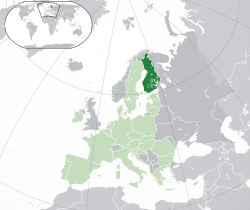
Back Финлиандиа Abkhazian Finlandia ACE Финланд ADY Finland Afrikaans Finnland ALS Финляндия ALT ፊንላንድ Amharic Finland AMI Finlandia AN Finnland ANG
| Suomen tasavalta Republiken Finland Républik Finlandia |
|||||
|---|---|---|---|---|---|
|
|||||
| Lagu Maamme (Basa Finlandia) Vårt land (Basa Swédia) "Lemah urang" |
|||||
 Lokasi Finlandia (héjo kolot) – di buana Éropa (héjo & kulawu kolot) |
|||||
| Ibu kota | Hélsinki | ||||
| Kota panggedéna | ibu kota | ||||
| Basa resmi | Basa Finlandia, Basa Swédia | ||||
| Basa régional | Basa Suomi | ||||
| Démonim | Finns, Finnish | ||||
| Pamaréntah | Républik Parleménter[1] | ||||
| - | Présidén | Alexander Stubb | |||
| - | Perdana menteri | Petteri Orpo | |||
| - | Perdana Menteri katunjuk | Jussi Halla-aho | |||
| Kamerdékaan | |||||
| - | Otonomi ti Swédia |
29 Maret 1809 | |||
| - | Déklarasi ti Bolshevik Rusia |
6 Désémber 1917 | |||
| - | Diakuan | 4 Januari 1918 | |||
| Asup ka Uni Éropa |
1 Januari 1995 | ||||
| - | Cai (%) | 10 | |||
| Populasi | |||||
| - | Perkiraan 2010 | 5,374,781 (ka-112) | |||
| - | Sénsus 2000 | 5,180,000 | |||
| GDP (PPP) | Perkiraan 2010 | ||||
| - | Total | $185.979 billion[2] | |||
| - | Per kapita | $34,585[2] | |||
| GDP (nominal) | Perkiraan 2010 | ||||
| - | Total | $239.232 billion[2] | |||
| - | Per kapita | $44,488[2] | |||
| Gini? (2000) | 26.9 (handap) | ||||
| HDI (2010) | |||||
| Mata uang | Euro (€)¹ (EUR) |
||||
| Zona wanci | EET (UTC+2) | ||||
| - | Usum panas (DST) | EEST (UTC+3) | |||
| TLD Internét | .fi, .ax ² | ||||
| Kode telepon | +358 | ||||
| 1 | Saméméh 2002: Markka Finlandia | ||||
| 2 | .eu ogé dianggo | ||||
Républik Finlandia (basa Finlandia: Suomen tasavalta, Basa Swédia: Républiken Finland) mangrupa hiji nagara Skandinavia nu kaasup ogé nagara Nordik. Nagara ieu aya di Eropa Kalér jeung mangrupa anggota Uni Eropa. Finlandia tepung wates jeung Swédia, Norwégia, jeung Rusia upami wates lautna nyaéta Laut Baltik di barat daya, Teluk Finlandia di kidul, jeung Teluk Bothnia di kulon. Ibu kota nagara ieu nyaéta Hélsinki.
- ↑ (en)Formerly a semi-presidential republic, it's now a parliamentary republic according to David Arter, First Chair of Politics at Aberdeen University, who in his "Scandinavian Politics Today" (Manchester University Press, revised 2008), quotes Jaakko Nousiainen in "From semi-presidentialism to parliamentary government" in Scandinavian Political Studies 24 (2) p95–109 as follows: "There are hardly any grounds for the epithet 'semi-presidential'." Arter's own conclusions are only slightly more nuanced: "The adoption of a new constitution on 1 March 2000 meant that Finland was no longer a case of semi-presidential government other than in the minimalist sense of a situation where a popularly elected fixed-term president exists alongside a prime minister and cabinet who are responsible to parliament (Elgie 2004: 317)". According to the Finnish Constitution, the President has no possibility to rule the government without the ministerial approval, and does not have the power to dissolve the parliament under his or her own desire. Finland is actually represented by its Prime Minister, and not by its President, in the Council of the Heads of State and Government of the European Union.
- ↑ a b c d "Finland". International Monetary Fund. Diakses tanggal 2011-04-21. Archived 2011-10-11 di Wayback Machine
- ↑ "Human Development Report 2010" (PDF). United Nations. 2010. Diakses tanggal 5 November 2010. Archived 21 Nopémber 2010 di Wayback Machine and "Human Development Index trends, 1980–2010" (PDF). United Nations. 2010. Diakses tanggal 7 November 2010. Archived 1 April 2012 di Wayback Machine

